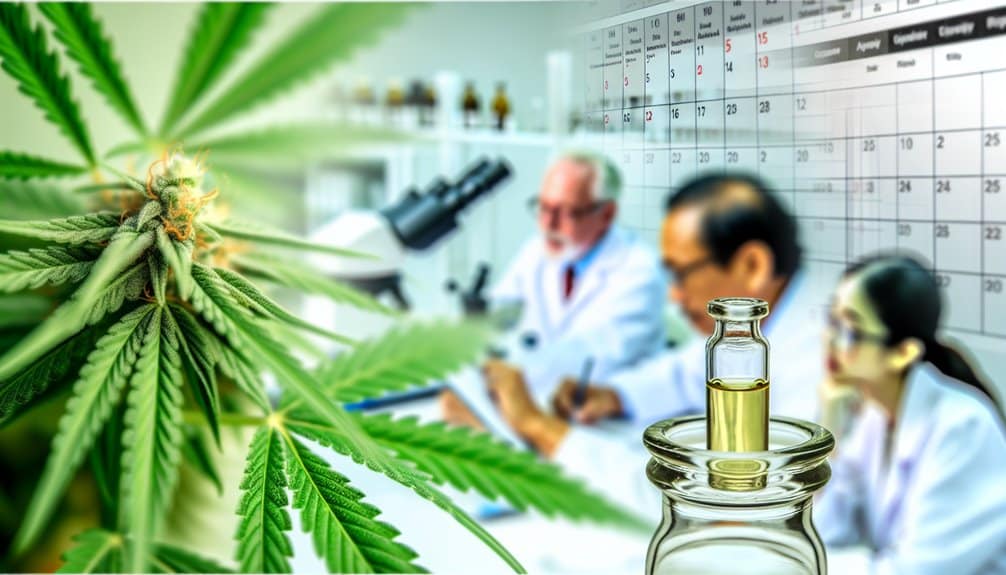You may not realize this, but as of October 2023, the legal landscape of medical marijuana in the United States is a complex patchwork, differing drastically from state to state. While you can access it for patient care in places like California and Arkansas, other states impose stringent regulations. The Rohrabacher-Farr amendment provides some federal safeguard for state laws, but it's not a foolproof shield. And with the FDA maintaining a tight grip on cannabis-derived products, it's a continually evolving scenario. Now, consider the potential reclassification of cannabis as a Schedule III drug – it's clear the future of medical marijuana is set for some significant shifts. But what exactly does this mean for patients, practitioners, and policymakers? Let's explore further.
Background: The Evolving Legal Landscape of Medical Marijuana

While California was the trailblazer in legalizing medical marijuana back in 1996, the majority of states have since followed suit. However, patient access varies greatly from state to state due to differing laws and programs. Despite the Rohrabacher-Farr amendment, designed to prevent interference with state medical cannabis laws, legal challenges persist at the federal level. The Justice Department continues to interpret the amendment in a way that authorizes raids and prosecutions. Fortunately, there's a glimmer of hope. The DEA announced plans to reclassify cannabis as a Schedule III drug, potentially easing some of the legal tensions. Still, for patients seeking access to medical marijuana, the landscape remains complex and fraught with legal obstacles. It's pertinent to note that the medical use of cannabis has a long history, dating back to ancient cultures, and was even popularized in Western medicine in the 1830s by Irish physician William Brooke O'Shaughnessy (history of medical cannabis use).
Medical Marijuana: a Brief Overview of Its Therapeutic Uses
Medical marijuana, often touted for its therapeutic potential, plays an essential role in managing a wide array of health conditions. Its therapeutic benefits are especially remarkable in providing pain relief for conditions like chronic pain, nerve damage, and fibromyalgia. It's also used to control nausea and stimulate appetite in patients undergoing cancer treatment or those with HIV/AIDS. Additionally, it shows promise in treating neurological conditions, reducing muscle spasms for multiple sclerosis patients, and lessening tremors in Parkinson's disease. Though not as effective for glaucoma and Alzheimer's, it may relieve symptoms in people with Crohn's disease and improve short-term sleep for conditions like obstructive sleep apnea. Remember, however, that its usage should always be under medical supervision. Despite the benefits, there are potential side effects, and high doses may lead to hallucinations or delusions.
The Role of FDA in Regulating Medical Marijuana

Despite the 2018 Farm Bill removing hemp from the Controlled Substances Act, the FDA maintains its authority to regulate products containing cannabis or cannabis-derived compounds. This regulatory framework guarantees the safety and effectiveness of these products through market oversight and strict product regulations. Currently, the FDA has approved one cannabis-derived and three cannabis-related drugs, subject to rigorous drug approvals process. The FDA's role also extends to setting research guidelines and standards for clinical trials. Their mission is to support scientifically valid research that substantiates therapeutic claims of cannabis products. While the FDA acknowledges state laws allowing medical use of cannabis, they encourage alignment with FDA's safety standards and clinical trial protocols to guarantee public health and safety.
The State-by-State Legal Status of Medical Marijuana
As you navigate through the complex landscape of medical marijuana laws in the United States, it is crucial to understand that these regulations vary considerably from state to state. State regulations impact patient access, often determining who can obtain medical marijuana and under what conditions.
Consider these four examples:
- Arkansas: Patients can possess up to 2.5 oz, but cultivation is generally illegal.
- California: Allows personal cultivation and possession of up to 8 oz.
- Kentucky: Legalized medical marijuana with a yet to be determined possession limit.
- Louisiana: Patients can have a one-month supply, but cultivation is prohibited.
Investigating the Efficacy of Medical Marijuana: Current Research Findings

While diving into the current research findings, one cannot overlook the significant impact of medical marijuana in managing pain effectively. Studies reveal a significant reduction in pain levels, with over 70% of patients reporting moderate to significant improvement. This improvement isn't just about pain relief; it's about enhancing patient outcomes regarding quality of life. With medical cannabis treatment, patients report better daily functioning, correlating with reduced consumption of other medications. Beyond pain, research also shows potential benefits for conditions like Alzheimer's and anxiety. You'll find that factors such as employment status and active driving relate to treatment success. Importantly, treatment adherence remains high, showing the real-life feasibility of medical marijuana as a therapeutic option.
Safety Concerns and Side Effects: A Closer Look at Medical Marijuana
Though medical marijuana has proven therapeutic benefits, it's vital to understand the potential safety concerns and side effects. Short-term effects may range from euphoria and altered senses to panic attacks and increased heart rate. Long-term use can lead to attention and memory deficits, lung damage, and increased risk of mental health disorders.
Safety regulations can mitigate some risks, but user education is important, particularly for:
- Vulnerable populations, like older adults and those with a history of psychosis.
- Users unaware of potential contamination issues due to inconsistent regulation.
- Those at risk of harmful interactions with other drugs.
- Pregnant women, due to potential risks to their unborn child.
Social and Economic Impacts of Medical Marijuana Legalization

Beyond the individual health implications of medical marijuana, the legalization of this plant has far-reaching social and economic impacts. You'll find economic growth with new jobs created by dispensaries and tax revenues collected from sales. These funds stimulate local economies, fueling further growth. Reduced costs in drug law enforcement also contribute to this economic uptick. On the social front, medical marijuana aids in public health improvement and social equity. It's linked to lower opioid-related harm, and fewer arrests for cannabis offenses can help rectify social disparities. However, challenges persist, such as regulatory costs, market fluctuations, and potential misuse. It's vital to navigate these complexities to guarantee the benefits of medical marijuana legalization are fully realized.
Future Prospects: The Path Ahead for Medical Marijuana in the U.S
As we venture into the future of medical marijuana in the U.S, significant changes are on the horizon. You'll face regulatory challenges, but promising market opportunities abound.
- Legislative Changes: The federal government is easing restrictions and streamlining research registration, opening up new avenues for exploration.
- Research Development: The Medical Marijuana and Cannabidiol Research Expansion Act will spur innovation in cannabis-based treatments.
- Educational Initiatives: With an increasing number of pharmacy schools incorporating medical cannabis courses, we'll see a rise in competent healthcare professionals well-versed in medical marijuana.
- Market Growth: Retail sales are projected to reach $53.5 billion by 2027, indicating a burgeoning market.
Stay ahead by being prepared, informed, and ready to serve your patients with the best possible care.
Conclusion
So, you're maneuvering through the murky waters of medical marijuana in the U.S., huh? It's a mix of evolving laws, potential benefits, and looming concerns. The landscape's as varied as a patchwork quilt, with each square representing a state's stance. But remember, change is the name of the game. As research expands and perceptions shift, so too might the legal and social fabric of medical marijuana. That's the long and short of it, my friend.
If you're curious to learn more about how medical marijuana can help you or someone you care about, I invite you to visit Fells Point Cannabis Docs in Maryland. They have a friendly and knowledgeable team ready to answer all your questions and guide you through the process. You can also give them a call at (410) 401-4200. Don't hesitate to reach out—taking that step could be a game-changer!
